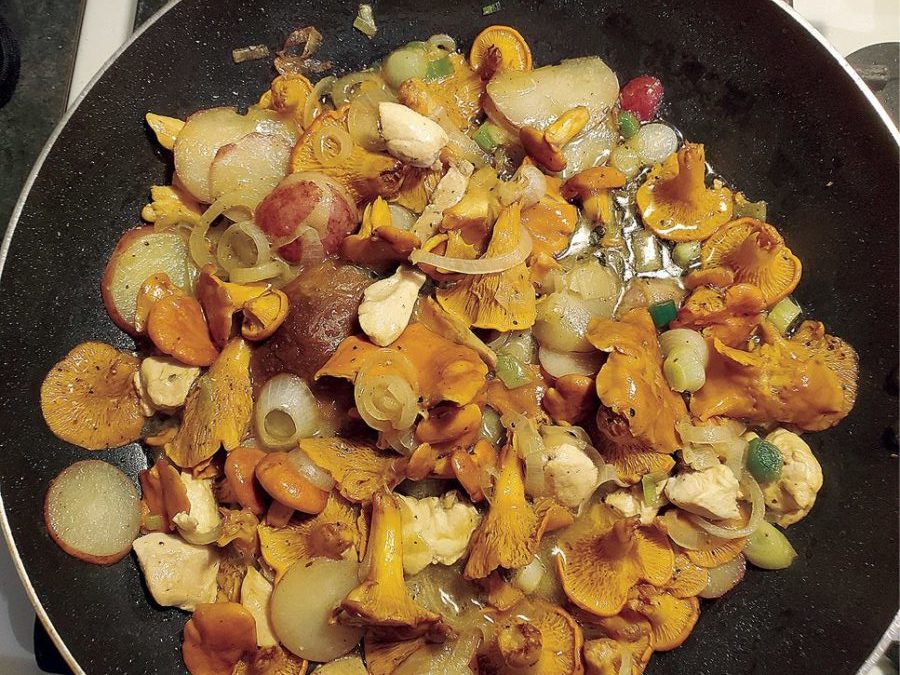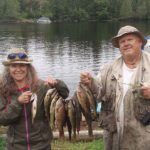It was more than 50 years ago when Grandpa Casey walked with me from the Casey home on Skyline Parkway up to the barren rock outcrops that supported the Antenna Farm overlooking Duluth. The “antennas” were actually sky-tickling transmission towers which, back then, were primarily for local radio stations. We weren’t interested in the towers’ radio signals so much as the wild strawberries that grew amidst the sparse grass beneath them.
Grandpa gathered enough of the tiny treats so Grandma could make a batch of wild strawberry jam, which may be the most delectable food on the planet. It takes an awful lot of the miniscule berries to make jam. I doubt my contribution to the basic ingredient amounted to much. The second most delectable food on the planet is a wild strawberry plucked from the vine, so few of my pickings reached the pail. Every spring since, I’ve found enough wild strawberries to pick at least a handful or two. That’s when I know summer has finally arrived in the North.
My second introduction to summer’s wild treats was blueberries, although I have so many early memories of picking them that it is hard to know which time was the first. For sure, it occurred either in the sand plains of northwest Wisconsin or somewhere north of Duluth. Wild blueberries are at best about half the size of the domesticated ones you buy at the market, but their flavor is much better than commercial berries. That’s why seeking the wild ones remains so popular.
The size and abundance of wild blueberries greatly depends upon the timing of the last frost and the amount of precipitation the plants received during the growing season. Both can lead berry pickers to pronounce whether a given summer is a poor or a good berry year. Blueberries grow in a variety of habitats, although it is best to look for them in open to semi open areas with gravelly or sandy soil. They are often especially numerous for a few years following a wildfire, until regrowing trees and other vegetation block sunlight from reaching the low-growing blueberries. They appear later than wild strawberries, although the timing depends upon the location and latitude.
The folks with whom I have picked blueberries over the years were never the hard cores who measured their take in gallons or bucketfuls and returned day after day to the patch. Instead, my picking companions were satisfied with enough berries for a pie or a couple batches of muffins. This task can be completed in an hour or two, which we considered enough time to be bent over beneath a hot sun, gathering tiny berries. If you are willing to spend more time at this task, more power to you.
I’ve long found picking wild raspberries more pleasurable, because you can do it standing up, the berries are bigger and, at least to my palate, better tasting. For a number of years, I spent many evenings picking raspberries in a patch shared only with the bears. The berries grew along the edges of a road through a logging job. The late Vikki used them in muffins, sauces and pies. Packages of frozen raspberries carried us through the winter and were thawed far more frequently than the blueberries with which they shared freezer space. Some folks thought we were foolish or had mixed up taste buds. Sometimes we had blueberries left over the following summer.
When I was a kid, we picked pails of chokecherries for jelly or wine. Both my father and his brother made chokecherry wine. The dark, rich wine wasn’t bad at all, but it took a fair amount of effort to make a batch. Dad gave it up when a couple of bottles containing not-fully fermented wine exploded like bombs in the basement. Not only was it a mess to clean up, but the smell of chokecherry wine lingered long in the basement.
Chokecherries are generally abundant where you find the bunches of shrubs, because they grow in clusters along the edge of human forest openings such as gravel pits or meadows. Another cherry shrub that is perhaps more widespread in the area is the pin cherry, which also grows in openings and along roads. The pin cherry looks and tastes more like a commercial cherry. Unfortunately, you generally don’t find even a handful of ripe ones, if you are lucky, because they are especially sought by chipmunks, as well as many birds.
Another common crop that grows on shrubs are juneberries or, as Canadians call them, saskatoons. Similar in appearance to blueberries, juneberries are flavorful and can be abundant if you find a cluster of shrubs. I generally eat them off the bush, although I’ve had them mixed with blueberries in a pie. I doubt most folks would notice any difference in the flavor or appearance of the final result.
Thimble berries are a late summer treat enjoyed by many hikers along the Superior Hiking Trail. Generally found about knee- to thigh-high above the forest floor, they resemble a large strawberry. Some folks think they are delicious. To me they are bland and never numerous enough to merit picking to bring home. On the other hand, I enjoy stumbling upon the bushes that produce high bush cranberries, after they have been touched by frost. Another wild crop I just pick and munch, high bush cranberries give you a double punch of vibrant flavor and thirst quench. Mostly I trip upon them while grouse hunting, although I still pick them early winter, when they are frozen. The cranberries that grow close to the ground, similar to the domestic versions you have at Thanksgiving, are uncommon here, at least in my experience. I remember picking enough to make a small batch of sauce while picking blueberries in a mossy bog near Duluth as a kid. The sauce was delicious. I’ve kept an eye out for them ever since, but rarely seen more than a few.
These days, my favorite wild crop grows not on a bush or shrub, but emerges from the ground. I have become an avid fan of lovely chanterelle mushrooms. They don’t grow everywhere near Lake Superior, but chanterelles are beloved by those who know them. Trumpet shaped and butter yellow, they are easy to identify once you know what you are looking for. They are more abundant and easier to spot than the better-known morels, which are uncommon along the North Shore. However, even if chanterelles are easier to find, don’t expect any pickers to give up their spots any more often than morel afficionados do. That’s because chanterelles are equally delicious.
Since I’ve picked nearly everything out there at one time or another, sometimes I wonder if personal tastes for what you like just run in a big circle. On what I believe was Vikki’s last berry picking adventure before she was taken before her time, we went to her favorite blueberry patch. We set out in separate directions, as we always did. When we met at the truck for a well-deserved break, she had very few blueberries. I asked why. She looked at me with big eyes and said “strawberries.” Then she held out her hand and showed me the biggest wild strawberries I’ve seen. Even though the strawberry season was long past, for some reason this patch nestled beneath young jack pines was at it’s prime. Vikki told me to go enjoy the special strawberries, while she picked some blueberries. I did, eating my fill as she had.
You can call me a mystic, but I have come to believe things occur for a reason. All I know is less than two years later, I sprinkled some of her ashes in that berry patch. It was the right thing to do.






